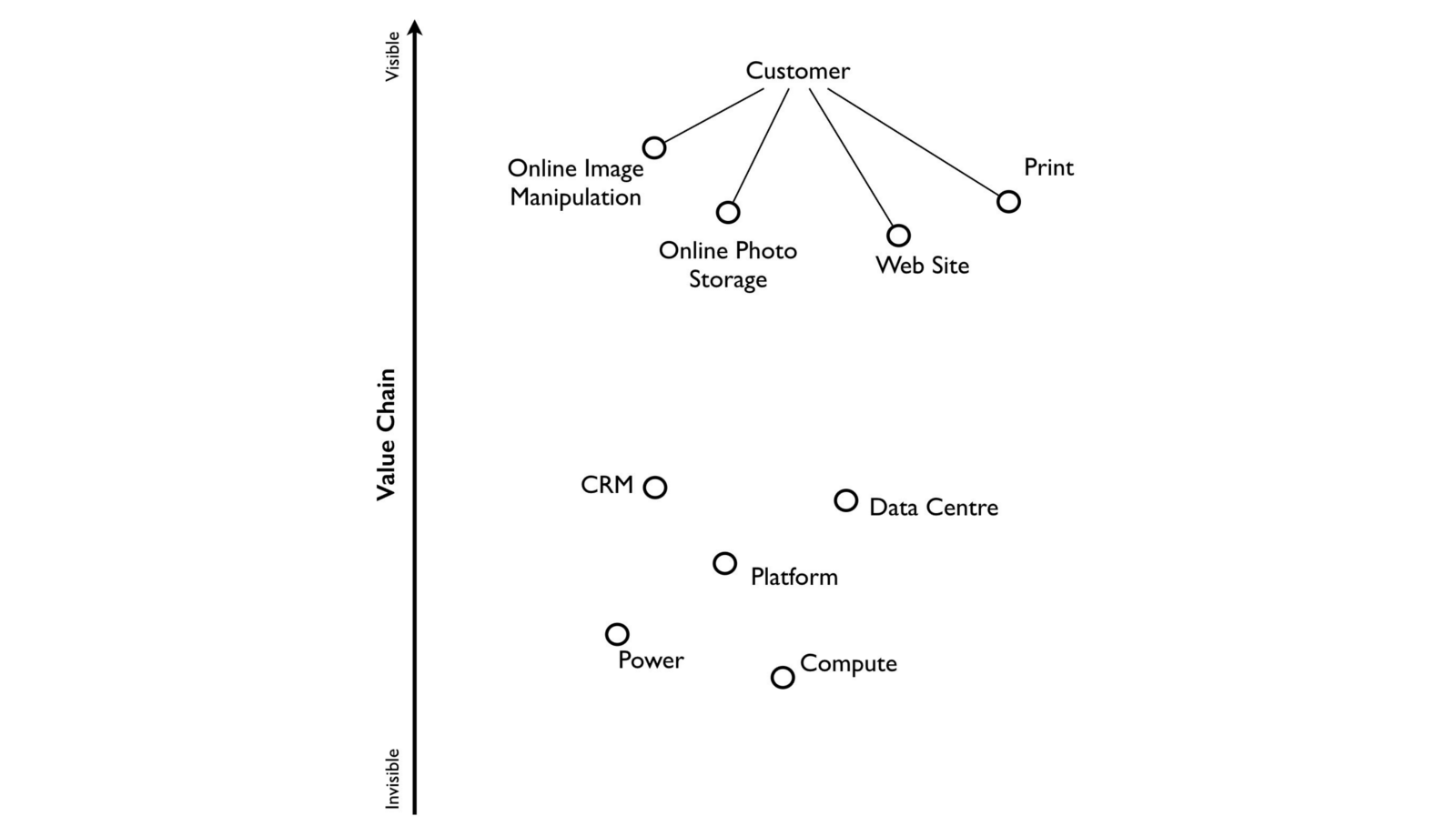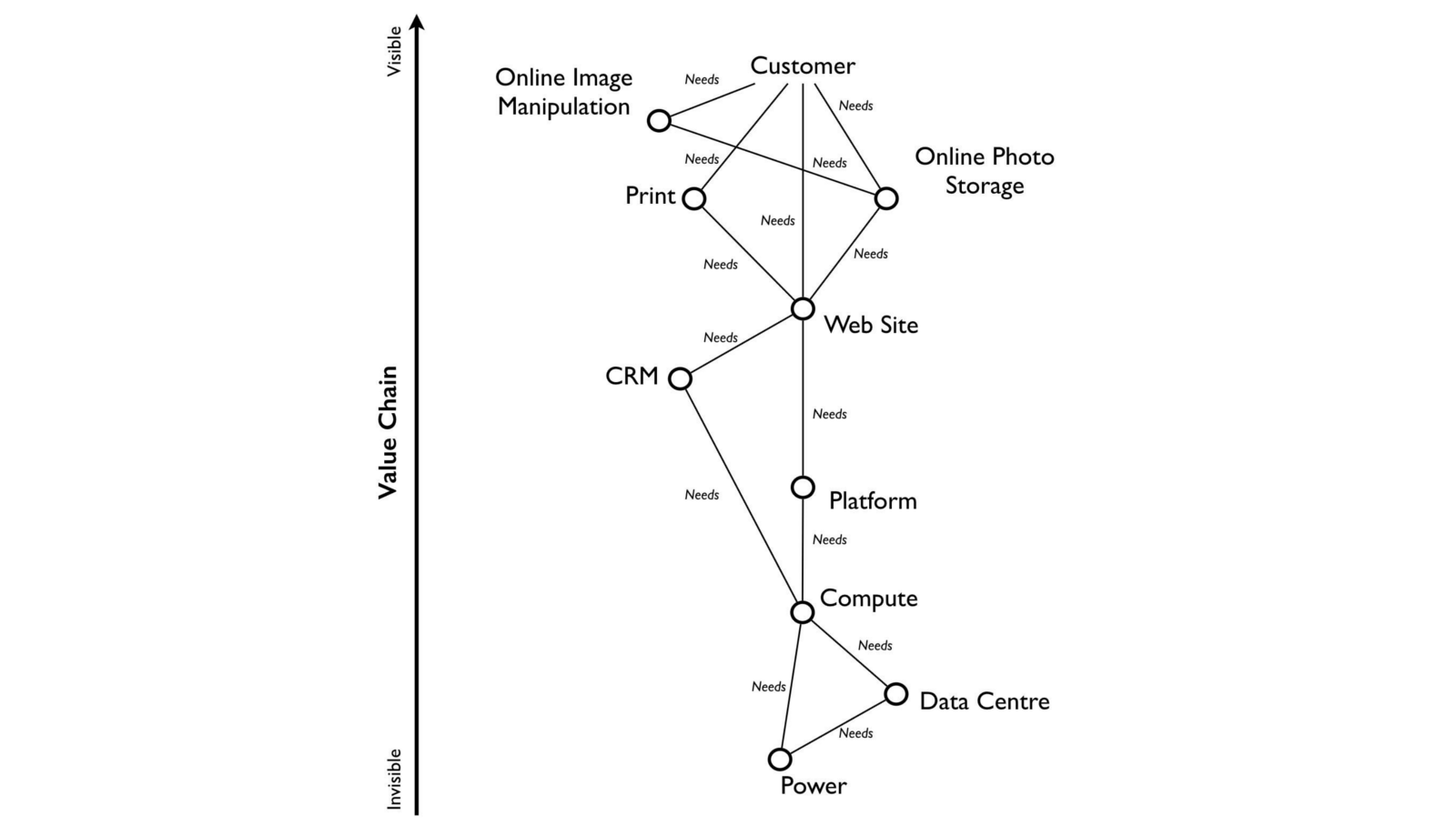Introduction
Video courtesy of iluli by Mike Lamb.
Wardley Mapping is licensed Creative Commons Attribution-ShareAlike 4.0, courtesy of Simon Wardley.
Definitions
Wardley Mapping /wôrdlē mapping/ verb
The process of making strategic decisions (leadership) based on the purpose ("the game"), a description of the competitive landscape (a map), the external forces acting on the landscape (climate), and the training of your people (doctrine).
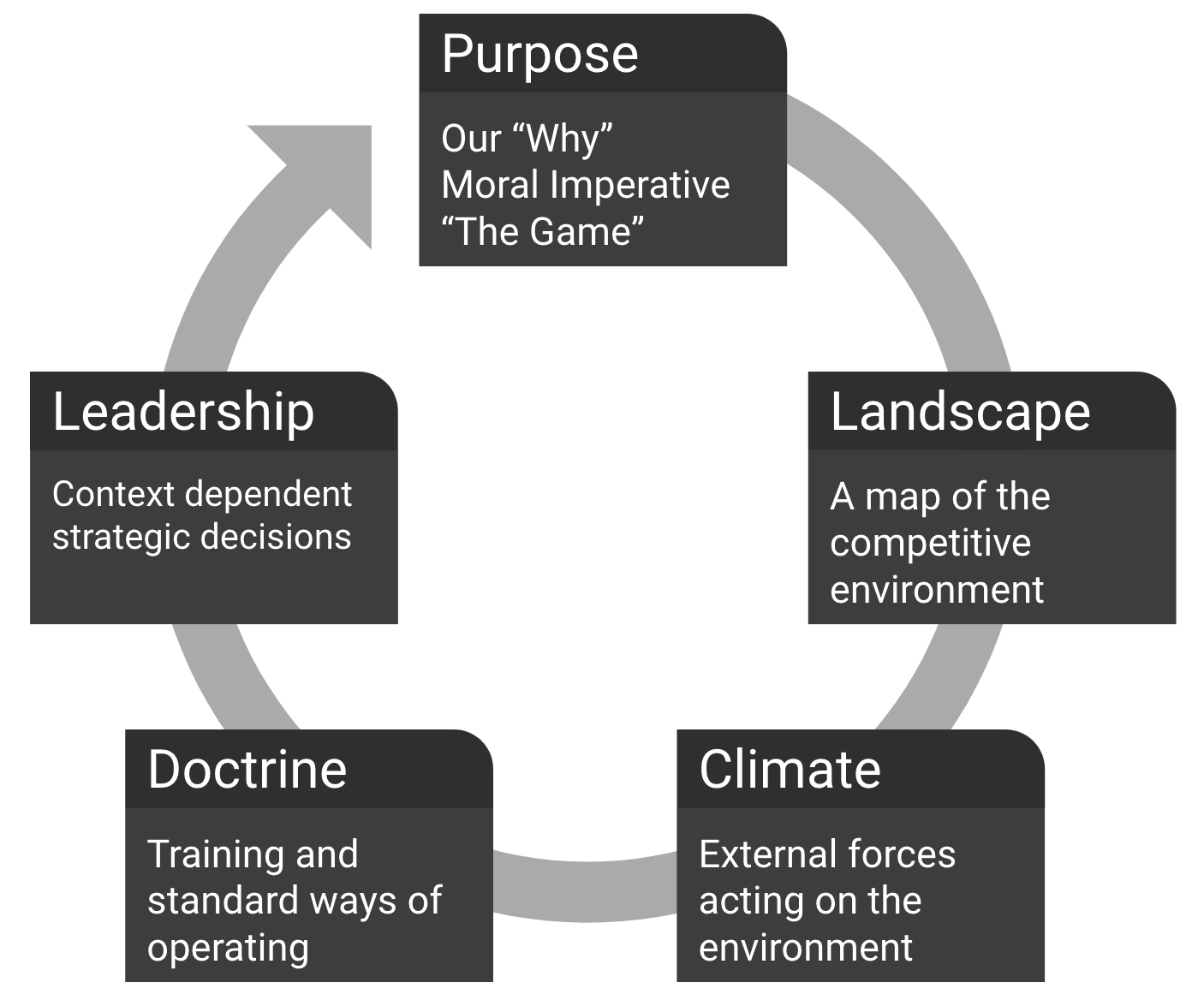
Strategy Cycle courtesy of Simon Wardley, CC BY-SA 4.0.
Wardley Map /wôrdlē map/ noun
A value chain — a chain of needs — (users, needs, and capabilities arranged and connected according to dependency) mapped against the four stages of evolution (Genesis, Custom, Product, and Commodity).

The Art of War
Simon Wardley, in his search to understand how to evaluate strategy, found answers in military history and Sun Tzu: The Art of War. Sun Tzu's Five Factors — Purpose, Landscape, Climate, Doctrine, and Leadership — covered the minimum set of considerations required for strategic decision-making.
In military contexts, a map formed the basis for understanding the Landscape. But in the absence of a tangible competitive landscape, could there be such a thing as maps in business? To find out, see Simon's book or keep reading.
Purpose
In Wardley Mapping, Purpose is "the game" being played. It defines the scope of what you are doing and why you are doing it. It may be a moral imperative or just what motivates you to come to work every day.
Purpose is the first step in the strategy cycle. Because many leaders do not understand the importance of Landscape, Climate, and Doctrine, they commonly shortcut the cycle and jump straight from Purpose to strategic decisions in Leadership. This "strategy by gut feel" is an inadequate approach for strategic thought.
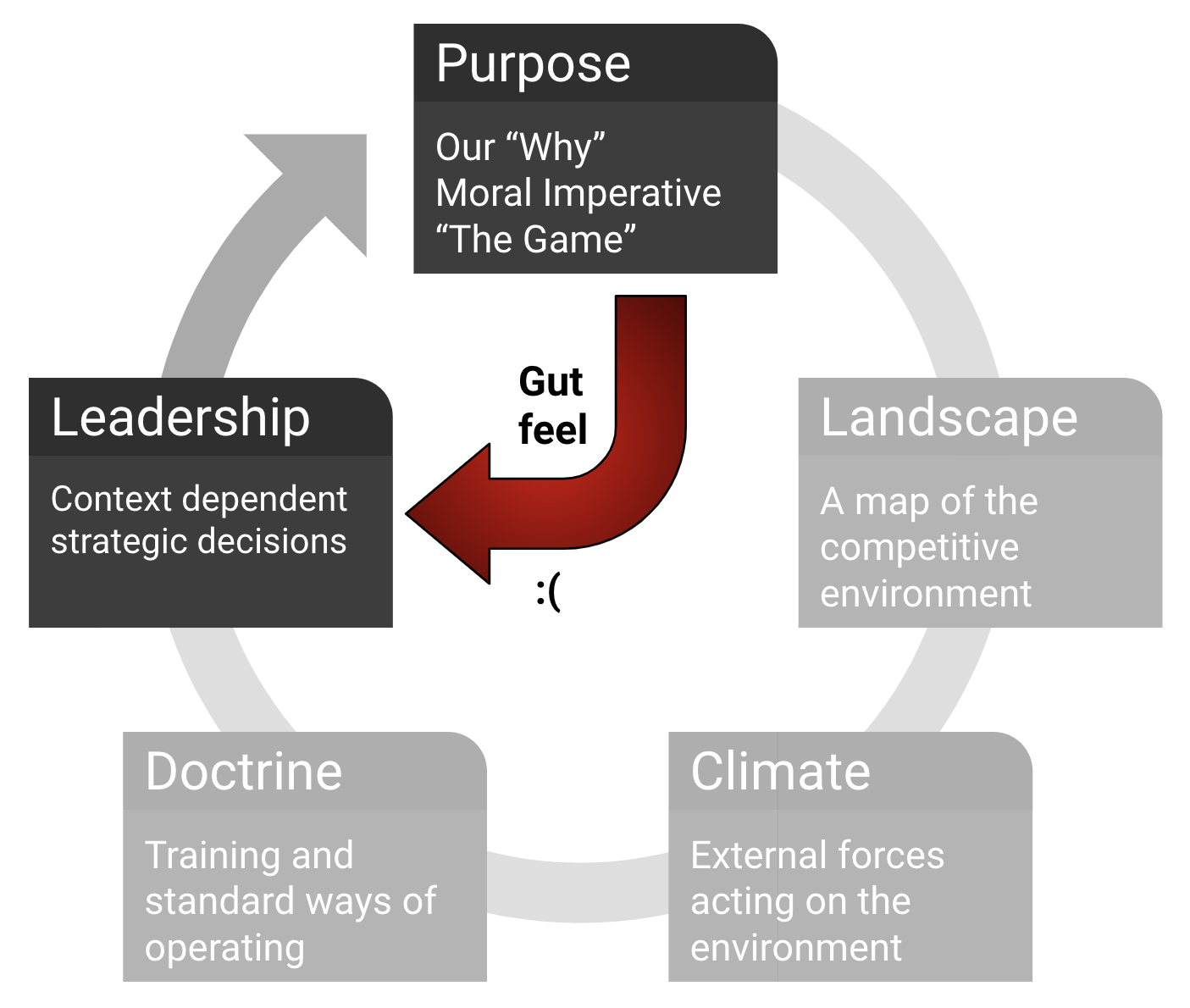
Strategy Cycle courtesy of Simon Wardley, CC BY-SA 4.0.
The climate may affect your purpose, the environment may affect your strategy and your actions may affect all... Your purpose isn’t fixed, it changes as your landscape changes and as you act. There is no “core”, it’s all transitional.
Landscape
A map of physical terrain is visual, specific to the battle at hand, and includes the position of troops and obstacles relative to an anchor (magnetic North).
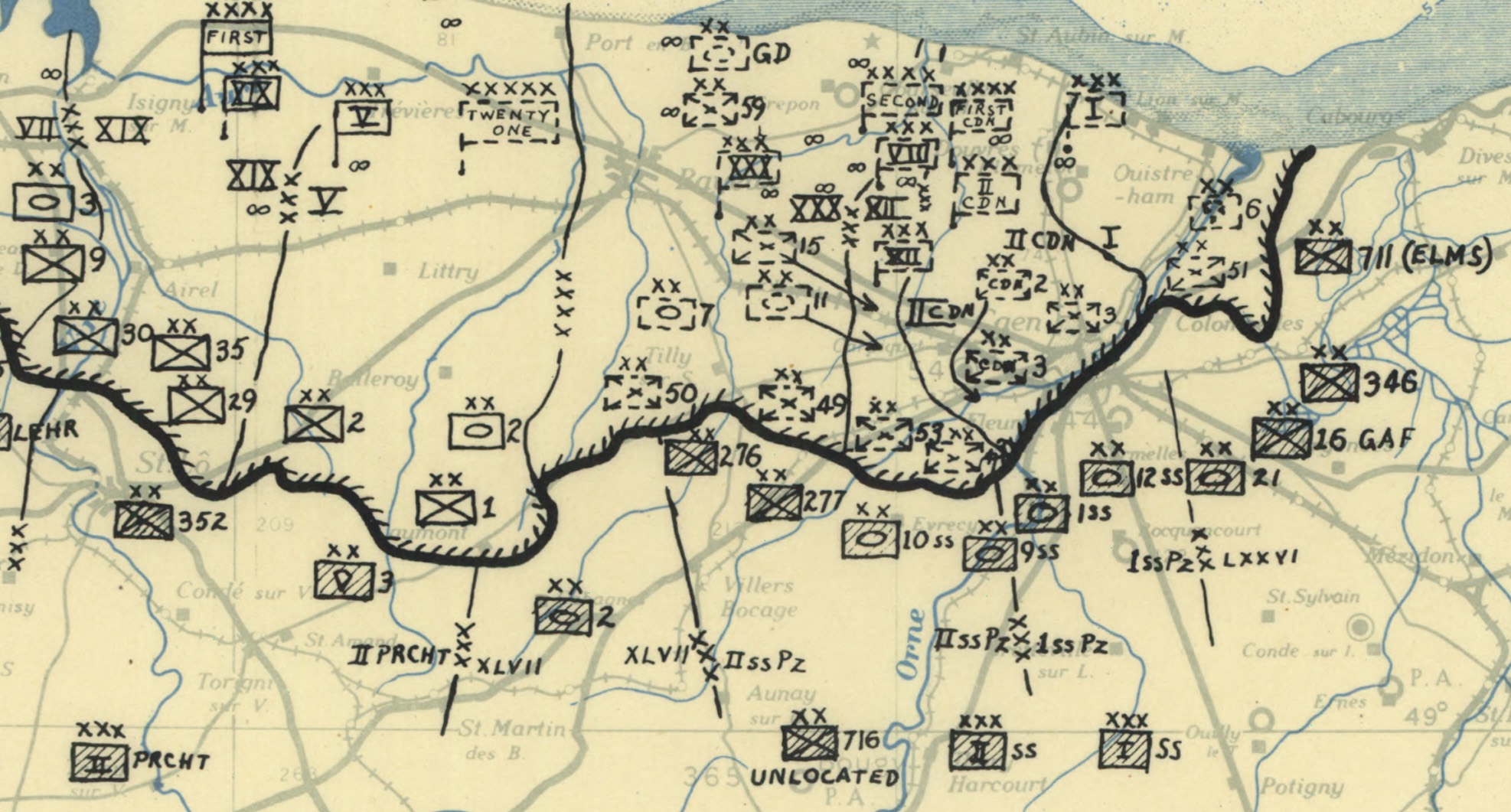
Twelfth Army Group situation map, 1944. Retrieved from the Library of Congress.
A map of a competitive business Landscape (a Wardley Map) is also visual and context-specific, but instead of magnetic North, the anchor is the User being served and their corresponding needs. And instead of troops, the map contains a value chain — capabilities necessary to fulfill the needs, arranged according to their dependency relationships.
The position of the capabilities on a Wardley Map is dependent on two aspects:
- Visibility to the user, which is a natural outcome of a component's relative position within the value chain, manually adjusted as needed.
- Evolutionary stage, as determined through evaluation of the component's general properties and characteristics.

Courtesy of Simon Wardley, CC BY-SA 4.0.
Making a Map
Wardley Mapping is a straight-forward process, and most difficulties boil down to concerns about making "mistakes" or doing the "wrong" thing. It is much more valuable to discard these concerns up-front, embrace the messiness of the process, and learn by boldly doing.
The process of mapping is also the process of constructing a model of reality. An incorrect model that is also useful is the definition of success.
To make a map:
- Identify the Users being served
- Identify the Needs to be met (think of these as top-level Capabilities)
- Identify the Capabilities needed to successfully meet those needs
- Determine the stage of Evolution for each Capability by evaluating its characteristics (if it's difficult to decide, try breaking the Capability down into multiple, smaller Capabilities)
- Draw the complete value chain — User at the top, Needs and Capabilities underneath, with dependency relationships included and Capabilities placed in Stages I, II, III, or IV of Evolution
The process can also look something like this...
Capability Types
Capabilities can be Activities (what we do), Practices (how we do it), Data (how we measure it), or Knowledge (how we understand it). Their manifestations in the different stages are shown below.
| Stage of Evolution |
I |
II |
III |
IV |
|---|---|---|---|---|
| Activities |
Genesis |
Custom |
Product
|
Commodity
|
| Practices |
Novel |
Emerging |
Good |
Best |
| Data |
Unmodelled |
Divergent |
Convergent |
Modelled |
| Knowledge |
Concept |
Hypothesis |
Theory |
Accepted |
Evolutionary Characteristics Cheat Sheet
The list of characteristics below may help as you determine how evolved something is. If you like, you can click cells to highlight them as you think.
Don’t worry if some of the terms are confusing... just use what you can. Like Chess, mapping is a craft and you will get better with practice.
| Stage of Evolution |
I |
II |
III |
IV |
|
|---|---|---|---|---|---|
| Characteristics | |||||
| Ubiquity | Rare | Slowly increasing consumption | Rapidly increasing consumption | Widespread and stabilising | |
| Certainty | Poorly understood | Rapid increases in learning | Rapid increases in use / fit for purpose | Commonly understood (in terms of use) | |
| Publication Types | Normally describe the wonder of the thing | Build / construct / awareness and learning | Maintenance / operations / installation / features | Focused on use | |
| General Properties | |||||
| Market | Undefined market | Forming market | Growing market | Mature market | |
| Knowledge management | Uncertain | Learning on use | Learning on operation | Known / accepted | |
| Market perception | Chaotic (non-linear) | Domain of experts | Increasing expectations of use | Ordered (appearance of being linear) / trivial | |
| User perception | Different / confusing / exciting / surprising | Leading edge / emerging | Common / disappointed if not used or available | Standard / expected | |
| Perception in industry | Competitive advantage / unpredictable / unknown | Competitive advantage / ROI / case examples | Advantage through implementation / features | Cost of doing business / accepted | |
| Focus of value | High future worth | Seeking profit / ROI? | High profitability | High volume / reducing margin | |
| Understanding | Poorly understood / unpredictable | Increasing understanding / development of measures | Increasing education / constant refinement of needs / measures | Believed to be well defined / stable / measurable | |
| Comparison | Constantly changing / a differential / unstable | Learning from others / testing the water / some evidential support | Feature difference | Essential / operational advantage | |
| Failure | High / tolerated / assumed | Moderate / unsurprising but disappointed | Not tolerated, focus on constant improvement | Operational efficiency and surprised by failure | |
| Market action | Gambling / driven by gut | Exploring a "found" value | Market analysis / listening to customers | Metric driven / build what is needed | |
| Efficiency | Reducing the cost of change (experimentation) | Reducing cost of waste (Learning) | Reducing cost of waste (Learning) | Reducing cost of deviation (Volume) | |
| Decision drivers | Heritage / culture | Analysis & synthesis | Analysis & synthesis | Previous experience | |
Based on Simon Wardley's Evolutionary Characteristics Cheat Sheet, CC BY-SA 4.0.
Climate
While understanding the competitive Landscape is extremely helpful, it's also important to understand the Climate — the external forces acting upon it. These are the broader rules of the game, the patterns of the seasons, and competitor actions.
Below are two patterns you've already encountered.
Pattern 1: Everything Evolves Through Supply and Demand Competition
If the conditions exist that a person or groups of people will strive to gain some form of advantage or control over others due to a constraint (i.e. a limitation of a resource or time or money or people) then we have competition.
If competition exists then the components effected will evolve until they become industrialised. This impacts everything from activities (what we do), practices (how we do something), data (how we measure something) to knowledge (how we understand something).
Genesis |
Custom |
Product
|
Commodity
|
|
Focus on exploring |
Focus on learning and developing the craft |
Focus on refining and improving |
Focus on ruthlessly removing deviation, industrialising, and increasing operational efficiency |
Pattern 2: Characteristics Change as Capabilities Evolve
The characteristics of a component in the uncharted space are not the same as the characteristics of the same component when it becomes industrialised.
A company has to manage both the extremes along with the evolution between them. It’s really important to remember that there is a transition from uncharted to industrialised. Don’t organise by the extremes alone.
| Uncharted | Industrialised | ||
| Chaotic | Ordered | ||
| Uncertain | Known | ||
| Unpredictable | Measured | ||
| Changing | Stable | ||
| Different | Standard | ||
| Exciting | Obvious | ||
| Future Worth | Low Margin | ||
| Unusual | Essential | ||
| Rare | Ubiquitous | ||
| Poorly Understood | Defined | ||
| Experimentation | Volume Operations | ||
| Differential | Operational Efficiency | ||
| Competitive Advantage | Cost of Doing Business | ||
Table of Climatic Patterns
Below are Climatic Patterns that can be studied and integrated into strategic thinking about Competition, Components (Capabilities), Finances, Inertia, Prediction, and Speed. Mouse over each cell for more detailed descriptions.
| Competitors | Competitors actions will change the game | Most competitors have poor situational awareness | ||
| Components | Everything evolves through supply and demand competition | Evolution consists of multiple waves of diffusion with many chasms | No choice over evolution | Commoditisation does not equal Centralisation |
| Characteristics change as components evolve | No single method fits all | Components can co-evolve | ||
| Financial | Higher order systems create new sources of value | Future value is inversely proportional to the certainty we have over it. | Efficiency does not mean a reduced spend | Evolution to higher order systems results in increasing energy consumption |
| Capital flows to new areas of value | Creative Destruction | |||
| Inertia | Success breeds inertia | Inertia increases the more successful the past model is | Inertia can kill an organisation | |
| Prediction | You cannot measure evolution over time or adoption | The less evolved something is then the more uncertain it is | Not everything is random | Economy has cycles |
| Two different forms of disruption | A “war” (point of industrialisation) causes organisations to evolve | |||
| Speed | Efficiency enables innovation | Evolution of communication can increase the speed of evolution overall | Change is not always linear | Shifts from product to utility tend to demonstrate a punctuated equilibrium |
Courtesy of Simon Wardley, CC BY-SA 4.0.
Doctrine
With an understanding of the Landscape and the external forces acting on it (Climate), next is the training of your people in the standard ways of operating and the techniques that you almost always should apply.
Below is one of the doctrinal principals worth considering carefully.
Principle 1: Use Appropriate Methods
In any large system, multiple methods (e.g., agile or lean or six sigma) may be used at the same time. You will need to be mindful of the particular context where each is appropriate.

Courtesy of Simon Wardley, CC BY-SA 4.0.
Table of Doctrinal Principles
Below are Doctrinal Principles that can be studied and integrated into organizational behavior. Simon recommends starting with the basics (Phase 1). Mouse over each cell for more detailed descriptions, and click cells multiple times to make a self assessment, rotating through weak, warning, good, and neutral (undetermined) statuses.
Phase 1: Stop Self-Destructive Behavior
| Communication | Use a common language (necessary for collaboration) | Challenge assumptions (speak up and question) | Focus on high situational awareness (understand what is being considered) | |
| Development | Know your users (e.g. customers, shareholders, regulators, staff) | Focus on user needs | Remove bias and duplication | Use appropriate methods (e.g. agile vs lean vs six sigma) |
| Learning | Use a systematic mechanism of learning (a bias towards data) | |||
| Operations | Think small (as in know the details) | |||
Phase 2: Becoming More Context Aware
| Communication | Be transparent (a bias towards open) | |||
| Development | Focus on the outcome not a contract (e.g. worth based development) | Be pragmatic (it doesn't matter if the cat is black or white so long as it catches mice) | Use appropriate tools (e.g. mapping, financial models) | Think fast, inexpensive, restrained, and elegant (FIRE, formerly FIST) |
| Use standards where appropriate | ||||
| Leading | Move fast (an imperfect plan executed today is better than a perfect plan executed tomorrow) | Strategy is iterative not linear (fast reactive cycles) | ||
| Learning | A bias towards action (learn by playing the game) | |||
| Operations | Manage failure | Manage inertia (e.g. existing practices, political capital, previous investment) | Effectiveness over efficiency | |
| Structure | Think aptitude and attitude | Think small (as in teams, "two pizza") | Distribute power and decision making | |
Phase 3: Better for Less
| Leading | Be the owner (take responsibility) | Think big (inspire others, provide direction) | Strategy is complex (there will be uncertainty) | Commit to the direction, be adaptive along the path (crossing the river by feeling the stones) |
| Be humble (listen, be selfless, have fortitude) | ||||
| Learning | A bias towards the new (be curious, take appropriate risks) | |||
| Operations | Optimise flow (remove bottlenecks) | Do better with less (continual improvement) | Set exceptional standards (great is just not good enough) | |
| Structure | Seek the best | Provide purpose, mastery, & autonomy | ||
Phase 4: Continuously Evolving
| Leading | Exploit the landscape | There is no core (everything is transient) | ||
| Learning | Listen to your ecosystems (acts as future sensing engines) | |||
| Structure | Design for constant evolution | There is no one culture (e.g. pioneers, settlers and town planners) | ||
Adapted by Tasshin Fogleman from this tweetstorm and Better for Less, courtesy of Simon Wardley, CC BY-SA 4.0.
Additional Instructions
By examining the doctrine in an organization, you can get an idea of how adaptable it is and how well it will respond to external change or gameplay. You can do this with your own organization, or with other organizations.
In-person? Gather several people from different levels of the organization and perform the above self-assessment together. Distributed? See this form-based assessment by Justin Stach.
Once you've assessed the current state of doctrine in your organization, you can go about addressing areas of weakness, starting with the first phase.
Leadership (Gameplay)
Given your Purpose, the Landscape, the Climate, and your Doctrine, now you can make an informed decision about which strategy is appropriate for the context and take action against it.
Conditions and Consequences
For most of us, the traditional idea behind strategy is the deployment of people against some objective. "If we do X, then we will achieve Y!" This approach entails a "means-ends" model, which creates only first-order effects and limits leadership to the choice of which objective to pursue.
An alternative approach is to examine the conditions that would make desirable consequences inevitable. Instead of pursuing one particular objective, the cultivation of the inherent potential within the situation to enable second-order effects makes many different desirable outcomes possible. Means-ends thinking is tactical in nature, while conditions-consequences thinking makes a grand-strategic approach possible.
Think of it like tending a garden. What are the conditions that enable life? Success isn't about putting seeds in the ground. Success is an inevitable outcome when the seeds, soil, lighting, watering, weeding, pruning, pest control, temperature, and seasons are all considered and integrated into a complete picture of what it means to have a garden. Any one of those conditions can threaten the success of the garden if not accounted for.
When you map, think about second-order interventions. Once you get past the basic doctrinal problems, like correcting bias, reducing duplication, focusing on user needs, and making maps in general, you'll start to reflect your more strategic intentions in the maps themselves (e.g., "We want to accelerate the evolution of this component."). The least brilliant thing to do at this point, however, is to brute force your way to that outcome.
Instead, study the inherent potential of the context closely. What are the indirect options that create multiple desirable possibilities, of which that outcome is one? See Deciphering Sun Tzu for a more in-depth exploration of these ideas.
Table of Stratagems
| Accelerators | Open approaches | Co-operation | Exploiting network effects | Industrial policy |
| Market enablement | ||||
| De-accelerators | Exploiting constraint | IPR | Creating constraints | |
| Dealing with toxicity | Pig in a poke | Sweat and Dump | Disposal of liability | Refactoring |
| Ecosystem | Sensing Engines (ILC) | Two factor markets | Alliances | Channel conflicts & disintermediation |
| Co-creation | Co-opting and intercession | Embrace and extend | Tower and moat | |
| User Perception | Fear, uncertainty and doubt | Artificial competition | Brand and marketing | Bundling |
| Confusion of choice | Creating artificial needs | Education | Lobbying / counterplay | |
| Attacking | Centre of gravity | Directed investment | Experimentation | Fool's mate |
| Playing both sides | Press release process | Undermining barriers to entry | ||
| Competitor | Ambush | Circling and probing | Fragmentation play | Misdirection |
| Reinforcing competitor inertia | Restriction of movement | Sapping | Talent raid | |
| Defensive | Defensive regulation | Limitation of competition | Managing inertia | Procrastination |
| Raising barriers to entry | Threat acquisition | |||
| Markets | Buyer / supplier power | Differentiation | Harvesting | Last man standing |
| Pricing policy | Signal distortion | Standards game | Trading | |
| Poison | Designed to fail | Insertion | Licensing play | |
| Positional | Fast follower | First mover | Land grab | Weak signal / horizon |
Based on Simon Wardley's, On 61 Different Forms of Gameplay, CC BY-SA 4.0.
A Scenario
As an example, where might you focus in the below scenario (view in MapScript) if you wanted to increase competition around content?

Image produced with MapScript, based on a scenario by Simon Wardley, CC BY-SA 4.0.
To increase competition in content, the obvious option is to cause the industrialization (evolution) of the creative studios. More competition among studios would result in more, better content, so how could we make that happen?
A naive move might be to launch an independent creative studio or form a strategic partnership to advance one particular studio, but that game can all-too-easily be lost. There are more interesting options in the lower-level constraints (a Fool's Mate).
If there were more competition among production systems, for example, the barrier to entry for new talent and therefore new creative studios would be lowered. An open approach would accelerate that process, indirectly causing increased competition among creative studios and ultimately content.
Chances are, the existing creative studios won't have the situational awareness to recognize the play for what it is. In fact, they might support it in the name of short-term cost savings. Wild! Read more on this scenario in Simon's post, Fool's mate in Business.
Glossary
| Name | Description |
|---|---|
| Context | Our purpose and the landscape |
| Environment | The context and how it is changing |
| Situational awareness | Our level of understanding of the environment |
| Actual | The map in use |
| Domain | Uncharted vs Transitional vs Industrialised |
| Stage | Of evolution e.g. Genesis, Custom, Product, Commodity |
| Type | Activity, Practice, Data or Knowledge |
| Component | A single entity in a map |
| Anchor | The user need |
| Position | Position of a component relative to the anchor in a chain of needs |
| Need | Something a higher level system requires |
| Capability | High level needs you provide to others |
| Movement | How evolved a component is |
| Interface | Connection between components |
| Flow | Transfer of money, risk & information between components |
| Climate | Rules of the game, patterns that are applied across contexts |
| Doctrine | Approaches which can be applied regardless of context |
| Strategy | A context specific approach |

Image courtesy of Simon Wardley, CC BY-SA 4.0.

